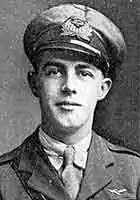Harold Day | |
|---|---|
 | |
| Born | 17 April 1897 Abergavenny, Wales |
| Died | 5 February 1918 (aged 20) Vicinity of Harnes, France |
| Buried | St. Mary's A.D.S Cemetery, Haisnes, Pas de Calais, France |
| Allegiance | United Kingdom |
| Service/ | Royal Navy |
| Years of service | 1917–1918 |
| Rank | Flight Sub-Lieutenant |
| Unit | No. 10 Squadron RNAS No. 8 Squadron RNAS |
| Awards | Distinguished Service Cross |
Flight Sub-Lieutenant Harold Day DSC (17 April 1897 – 5 February 1918) was a Welsh World War I flying ace credited with 11 confirmed aerial victories.[1]
World War I
Day was the son of William John and Elizabeth Day, of Wernddu, Abergavenny, Monmouthshire.[2] He joined the RNAS as a probationary temporary flight officer, and was commissioned as a temporary flight sub-lieutenant on 30 June 1917.[3]
He first served in No. 10 Naval Squadron, flying a Sopwith Triplane. He scored his first aerial victory with them, sending an Albatros D.V down out of control on 12 August 1917. He was then posted to No. 8 Naval Squadron and flew the Sopwith Camel for his remaining ten victories. During December 1917, he teamed with Guy William Price to drive down DFW two-seater reconnaissance aircraft on three different days. Fighting solo, Day destroyed one enemy aircraft and drove down three others during January 1918. On 2 February 1918, he joined Robert J. O. Compston and three other RNAS pilots in destroying a German reconnaissance aircraft, and in driving down an Albatros D.V later in the day. On 5 February, he joined three other RNAS pilots in destroying a reconnaissance machine; that brought his total to one enemy aircraft destroyed solo, two more shared, and eight driven down out of control. He then dived on another German aircraft.[1] Day's Camel came to pieces during the dive, plummeting him to his death.[4] Günther Schuster of Jasta 29 was credited with the victory.[1]
Day was awarded the Distinguished Service Cross, which was gazetted on 22 February 1918.
He is buried at St. Mary's ADS (Advanced Dressing Station) Cemetery, Haisnes, France.[2]
Honours and awards
- Distinguished Service Cross
- Flt. Sub-Lieut. Harold Day, R.N.A.S.
- In recognition of the skill and determination shown by him in aerial combats, in the course of which he has done much to stop enemy artillery machines from working. On 6 January 1918, he observed a new type enemy aeroplane. He immediately dived to attack, and after a short combat the enemy machine went down very steeply, and was seen to crash. On several other occasions he has brought down enemy machines out of control.[5]
References
- Notes
- 1 2 3 "Harold Day". The Aerodrome. 2014. Retrieved 18 November 2014.
- 1 2 "Day, Harold". Commonwealth War Graves Commission. 2014. Retrieved 17 November 2014.
- ↑ "No. 30261". The London Gazette. 31 August 1917. p. 9033.
- ↑ Franks (2003), p.23.
- ↑ "No. 30536". The London Gazette (Supplement). 19 February 1918. p. 2305.
- Bibliography
- Franks, Norman (2003). Sopwith Camel Aces of World War I: Volume 52 of Aircraft of the Aces. London, UK: Osprey Publishing. ISBN 978-1-84176-534-1.